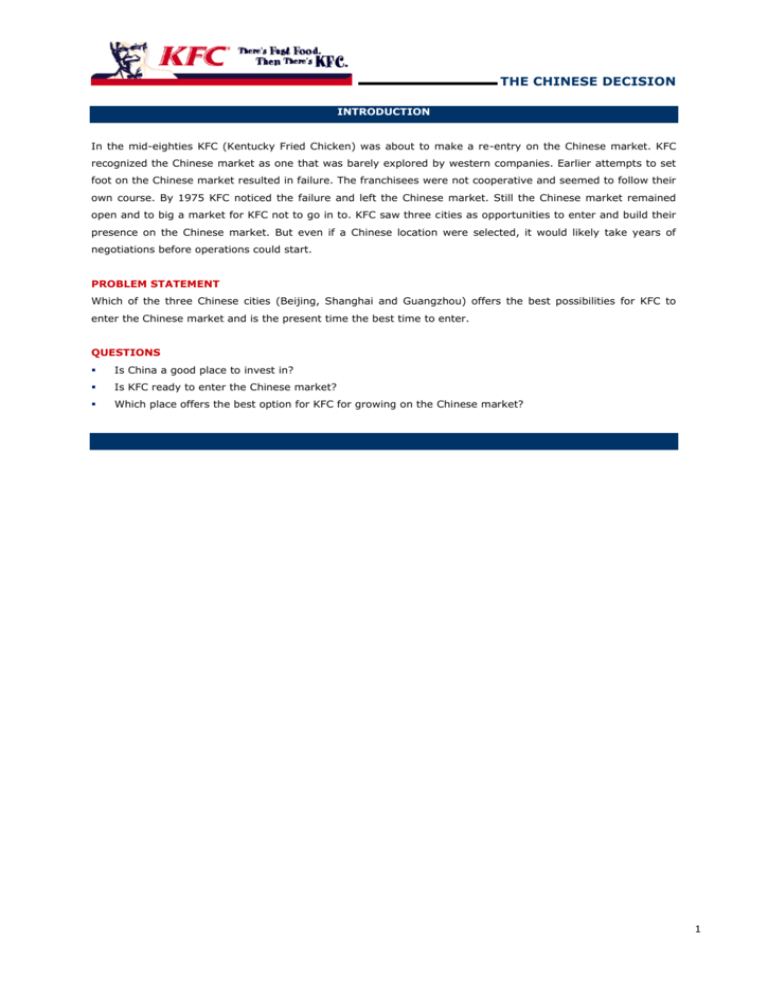Kentucky Fried Chicken
advertisement

THE CHINESE DECISION INTRODUCTION In the mid-eighties KFC (Kentucky Fried Chicken) was about to make a re-entry on the Chinese market. KFC recognized the Chinese market as one that was barely explored by western companies. Earlier attempts to set foot on the Chinese market resulted in failure. The franchisees were not cooperative and seemed to follow their own course. By 1975 KFC noticed the failure and left the Chinese market. Still the Chinese market remained open and to big a market for KFC not to go in to. KFC saw three cities as opportunities to enter and build their presence on the Chinese market. But even if a Chinese location were selected, it would likely take years of negotiations before operations could start. PROBLEM STATEMENT Which of the three Chinese cities (Beijing, Shanghai and Guangzhou) offers the best possibilities for KFC to enter the Chinese market and is the present time the best time to enter. QUESTIONS Is China a good place to invest in? Is KFC ready to enter the Chinese market? Which place offers the best option for KFC for growing on the Chinese market? 1 THE CHINESE DECISION INTERNATIONAL DEVELOPMENT WORLD R.J. Reynolds acquired KFC in 1982. This gave KFC the financial backing for expanding internationally. Chicken is eaten everywhere in the world. This gives KFC an huge advantage. It is not a question whether customers will eat it. It is just a matter of offering it in the best way. Franchising played a major role in domestic growth and KFC uses that also internationally now. Especially in countries with political risk and cultural unfamiliarity. Franchising is easy but it also means that KFC has less control over the businesses. KFC is urged to use the help of locals who are mostly profits oriented and cut corners to get the best revenue they can get. Conclusion: KFC can rely on the financial backing of Reynolds. The risk of franchising can therefore be taken. Although it means less control and it might prove to be difficult in maintaining the KFC international image. SOUTHEAST ASIA Southeast Asia is handled by a separate part of the company under the KFC holding. This enables KFC to target the Southeast Asian markets more effectively. A great deal of knowledge of the Asian culture is gained by stores in Indonesia, Malaysia and Singapore. The current man in charge is Tony Wang who is half American and half Asian. He speaks Cantonese and has proven to have commitment with KFC . He is also very entrepreneurial and wants to take risks. Local franchisers are necessary to work with in this area. Conclusion: The Asian market can be effectively targeted because it is recognized as separate. Other Asian countries have given the knowledge of the area. The current man in charge Tony Wang has high commitment with and knowledge of KFC and the target market. COMPETITOR ANALYSIS In 1985 KFC moved back into Hong Kong. During ten years of absence major competitors as McDonald’s, Burger King, Wendy’s and Pizza Hut had entered the Market. The Chinese people got “a taste of for western food”. There were few competitors that had dared to enter the big Chinese market outside Hong Kong. While chicken is eaten almost everywhere in the world, the same is not true for beef which has been poorly recieved in many countries. This was what held the big competitors back from entering the Chinese market outside Hong Kong. This provides KFC with a considerable advantage for penetrating foreign markets. Conclusion: The main competitors are McDonald’s, Burger King, Wendy’s and Pizza Hut. The intensity of those players on the Chinese market is very low. The market shows an interest in fried chicken rather than beef. 2 THE CHINESE DECISION IS IT THE TIME TO INVEST IN THE CHINESE MARKET? Opportunities Competitors stay away because beef is not popular in China and as a result competitors have invested in the market but not a lot. Hong Kong and other Asian places show that customers welcome the fast food fried chicken industry. The poultry industry is one of the top priority categories in China’s agriculture modernization and it is highly encouraged by the government. It is a huge, high profile market. With enormous growth opportunities An different 50/50 joint venture of US/China in the restaurant business proved to be a success. Orchid Food used the combination of take-out/80 seats restaurant. Poultry is eaten throughout the country. Threats Entry could be successful but KFC has to establish a very good poultry supply system. In order to supply its stores with chicken. The demand for precious managerial resources. American managers are culturally out of touch. The market in every place and city in China differs. There is a need to work together with a local. Chinese government prohibits foreign companies of owning more than 49% of the company. Commitment of franchisees is low. The market demands high start-up costs of time consuming training programs to change Chinese eating attitudes. Up-front investment needed to find and negotiate a partnership, to sign a lease and get operating permits. Conclusion The Chinese market seems barely explored but ready for KFC’s fried chicken fast food service. In other places in Asia the customers show huge interest in fast food chicken. The attitude towards eating should be easy to change, after all the Chinese eat everything with wings! But KFC needs to establish or find a good poultrysupply system but the supportive Chinese government in the poultry industry will most likely help KFC in doing so. Though KFC needs to be prepared to invest money in the establishment of a KFC-Chinese market. It is the time to invest. The Chinese market has great potential and as Tony Wang said: “It has to great a potential to be left undeveloped as a company operation!” STRENGHTS AND WEAKNESS OF KFC Strengths A strength in Human recourses gains the following: Selecting a group of entrepreneurial managers. Internal career opportunities make people have high commitment. Franchising avoids the high capital costs associated with expansion. Profits growth keeps KFC attractive for potential future franchisees. Focusing on what they do best. Make fried Chicken. A separate division within the corporation handles a separate geographic region. Ta-Tung (Tony) Wang was born from a province in China. He knows the Chinese people and its culture. Already 85 franchise stores in Southeast Asia. Focusing the companies’ activities on one thing. Get all noses in the same direction. 3 THE CHINESE DECISION Weaknesses Relying on local franchisees gains the following weaknesses. Franchising means less control over stores. Not much control over local franchisees. Control is difficult to maintain. A conservative look on penetrating international markets.. The limited number of Chinese-speaking KFC managers. A lot of management changes. A lot of people change position within the company. Conclusion KFC shows to have a neck for hiring the right person for the job. Putting a Chinese in charge is attacking potential difficulties with Chinese culture. KFC sees the Southeast Asian market as a separate whole. By doing that KFC can target that market as separate marketing and operational-wise. KFC has to change its vision on investing though. CONFRONTATION MATRIX 4 THE CHINESE DECISION Human recourses. Appeal to potential future franchisees. Head of southeast Asia department is Chinese. Franchising to avoid high capital STRENGTHS costs. Focusing companies’ activities. 85 stores in Southeast Asia. Separate department focusing on Southeast Asia. Relying on local franchisees. Conservative look on investing in WEAKNESS foreign markets. Limited number of Chinese speaking managers. Many position changes in the management. Main Points of Attention (MPA’s) MPA 1: How should KFC deal with local franchisees while the culture and customs in China differ from city to city? MPA 2: How should KFC deal with the Local and Chinese government when there are limited people who speak Chinese and there are a lot of changes in management? MPA 3: How should KFC deal with their conservative look on investing in foreign markets while the market high up-front investments and start-up costs demands? MPA 1: The Chinese market differs from city to city. Thus, KFC has to be aware that every potential franchisee differs from another. The control of local franchisees is very hard and the commitment of them has proven in the past to be extremely low. 5 system. Need of good poultry supply Up-front investments needed. Start-up costs. Low commitment franchisees. Work with local government. to city. The market differs from city management. Precision human resource country. THREATS Poultry is eaten all over the Huge growth potential. of Chinese government Poultry is main support topic places show huge interest. Customers in other Asian Not many competitors. OPPORTUNITIES THE CHINESE DECISION KFC handles this problem by relying less on franchisees and more on joint ventures with local partners. Also a back to basics strategy supported by a series of staff training programs, random inspections of company-owned and franchise stores would help higher the control of the local franchisees. MPA 2: The Chinese culture is hard to understand and the government even harder. Chinese partners gain trust in a person rather than a company. KFC has a lot of internal position changes. People get promoted. For the Chinese this means that they will deal with, for them, a different face. This is hard to do in Chinese culture. Also the fact that a low number of people in KFC’s management speak Chinese (either Cantonese or Mandarin) is difficult. Relying on a translator in negotiations with the Chinese government can be hard. In the Chinese culture is not always understood when a negative answer is given. The translator might change his translation in order to keep his job. KFC handles this perfectly by having a good Human Resource division. KFC is able to find the best person for the job. And with Ta-Tung (Tony) Wang they have someone who is Chinese, speaks Chinese and understands the “traps” of the Chinese culture. Though the possibility that the Chinese government will interfere for political purposes remains. MPA 3: Having a conservative look on investment in foreign markets, KFC will have to make a choice whether they are really willing to go into China. The Chinese markets demands high costs as for start-up the operation. Also negotiating with and finding potential Chinese partners demands a great amount of up-front costs. It is not in the nature of KFC to just supply this. KFC reacts on this by backing Tony Wang. KFC’s head management expressed their management that Wang pursue the Chinese market according to his best judgment and efforts. The trust him an gave him “CarteBlanche”. 6 THE CHINESE DECISION CHOOSING A OPTION FORMULATING OPTIONS Location Shanghai Positive points Most prosperous business center with 11% of China’s industrial output and 17% of core exports. Self-administered municipalities. Huge western influence and business. Very good poultry-supply system. Possibilities of after media exposure. Guangzhou Beijing Close to and easy to reach from Hong Kong. A form of self-autonomy in investment projects such as tax-rates. 80% of foreign investment in China Capital of Special Economic Zone Guandong. Culture used to western business. Good demographic facilities. Great tourist center FEC return promised Many poultry suppliers just outside the city. Concerns Noise and pollution discourages tourists. An accountable return in FEC (Foreign Exchange Currency) needs to be presented. Difficulty in finding a chicken supplier. Government interference for political purposes. OPTION CHOSEN The biggest problem of the Chinese market is for KFC to find or build a good poultry-supply system. they have realized that in the rest of the world. Although that is one of their strengths the Chinese market could pose a problem. The option of Beijing fails to solve this problem. From the MPA’s we could extract another problem. This problem is dealing with the government in China. Although this problem exists for all options, Shanghai is one of the three self-administered municipalities. 7




